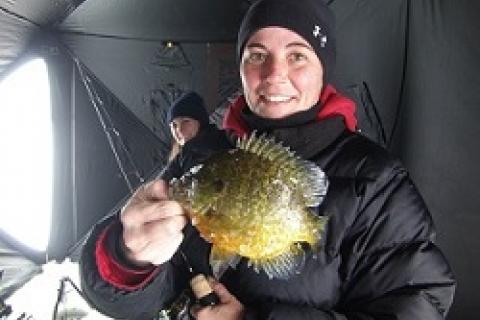
Early Iced Bluegills With OutdoorsFIRST Media
As the ice forms early this year because of an anomaly called the ‘polar vortex’, ice anglers across North America are getting ready to chase down their favorite targeted species. For many, that’s the best fish in the frying pan; bluegills.
‘Gills are abundant and available in thousands of lakes and rivers, and are active and willing to bite all winter. Finding them is not rocket science, but finding the largest bluegills in each system isn’t easy.
 Here’s a top ten list of tips to find and catch some bull bluegills this early ice season.
Here’s a top ten list of tips to find and catch some bull bluegills this early ice season.
1) The first place to look for bluegills for most folks is weeds, especially broad leaf cabbage if it’s available. Check the pockets and the edges first; using an Aqua-Vu Micro camera makes that easy. Drill a set of holes covering the area in a zig-zag pattern from shallow to the deep edge, and look around with your camera before you fish. Be mobile. Move with the fish as you find them, and if you find them in a spot where you can set up and fish for the day, pop up a Frabill Hub and stay warm and comfortable.
2) Don’t forget wood and rock edges. In some lakes, the really nice ‘gills hang out in the stumps and timber and along the deep edge leading to the structure wood creates, and on the rock edges especially on sharp break lines where round rock is predominant. If you know an area like this, check it with the camera, it can really pay off on unpressured bluegills.
3) Cribs are magic for early gills. If you have some marked on your GPS, check them all to find the larger schools.
4) Some lakes offer a stunningly good open water bite, even very early in the season. Sand grass on the bottom is the key to this bite. Sand grass is a bottom hugging vegetation that pan fish love to snuggle down into during the bright sunlight period of the day. It’s amazing to watch them rise up out of that cover and start looking for something to eat as the sun hits the horizon.
5) Bait selection can be critical to success. Let the gills tell you what they want by switching out if they are not immediately smoking your jig. Wax Worms, spikes, mousies, and similar grubs are very popular and effective, but nothing beats micro plastics for an active bluegill bite.
6) Go small on the ice jig. Use a jig that matches the size and aggressiveness of the gills you are on. Make sure the hook is large enough to hold a 10” plus Bull if the big gills are under you, but try the smallest jig your are comfortable with first, going larger as the bite dictates.
7) Use a Frabill light or ultralight ice combo. There’s a huge selection of rods that are matched to your technique. For the mobile angler use the longer rods, it’s easier when standing to detect the bites and control the lure action with a 20” or longer rod. The Straight Line series Frabill pioneered work really well for bluegills keeping line twist to a minimum and in that process reducing ‘jig spin’. Thousands of hours watching gills on an Aqua- Vu cameras has taught us that a spinning jig will get plenty of lookers, but few takers. Check out the Black Ops selection of rods at Frabill for mobile use in shallower water.
8) Use light line. The heaviest line one should use for finicky bluegills is 4#, and from 1# to 3# may be necessary some days to get the proper presentation including drop speed and lure action to trigger the fish to eat.
9) Sit relatively still on ice 4” to 6” thick, we have seen sudden loud steps or a loud scraping noise spook a school of mature Bull gills chasing them off as far as 30’away. A Sit and Fish Frabill bucket will anchor your fanny to the spot without making a ton of noise with your feet and will offer far more comfort than standing or kneeling, even on the padded articulated knees of your Frabill ice bibs. One can then also collect the gills from each hole as one moves, and carry them along.
10) Limit your take instead of taking your limit, especially if on a bite offering really big bluegills. Truly big gills can be 5 years old and older, and the numbers of big gills will be limited enough to be worth conserving so as the next year class reaches maximum size, there’s still numbers of each year class available. Many states are limiting the take to anywhere from 15 to 25 per angler; if you want great fishing into the future on your favorite bull gill spot, take fewer home each time and spread out the enjoyment from season to season.
- 4117 views

